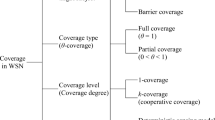Abstract
Coverage and tracking of multiple targets, are viewed as important challenges in WSNs, mainly aimed for future ubiquitous and pervasive applications. Target coverage in WSNs with large numbers of sensor nodes and targets, and with a predefined placement of sensors, may be conducted through adjusting the sensing range and considering the energy consumption related to this operation. In this paper, we encounter the problem of multiple target coverage in WSNs by determining the sensing range of each sensor node to maximize the total utility of the network. We solve this Network Utility Maximization (NUM) problem via two approaches, primal and dual decompositions, which result in iterative distributed price-based algorithms. Convergence of sensing ranges to optimal values is proved by means of stability analysis and simulation experiments. Simulation results show convergence to optimal values in few iterations, with near optimal values for the total objective function and energy consumption of nodes. These results show scalability of our algorithm, in terms of the number of iterations needed for convergence when compared with the other two methods. Furthermore, the distributed algorithm based on dual decomposition is used to cover efficiently moving targets in consecutive time intervals.
Similar content being viewed by others
References
Wang B (2010) Coverage control in sensor networks. Springer, London
Ghosh A, Das SK (2008) Coverage and connectivity issues in wireless sensor networks: a survey. Pervasive Mob Comput 4:303–334
Baumgartner K, Ferrari S (2008) A geometric transversal approach to analyzing track coverage in sensor networks. IEEE Trans Comput 57(8):1113–1128
Wang W, Srinivasan V, Wang B, Chua K-C (2008) Coverage for target localization in wireless sensor networks. IEEE Trans Wirel Commun 7(2):667–676
Nanmaran A, Ponnavaikko M, Karthick N (2009) Target tracking with integrated coverage in wireless sensor networks. In: Proc of the int conf on advances in computing, control and telecommunication technologies, Trivandrum, Kerala, India, pp 806–808
Kung HT, Vlah D (2003) Efficient location tracking using sensor networks. In: Proc of IEEE WCNC, New Orleans, LA, USA, pp 1954–1961
Wu J, Yang S (2004) Coverage issue in sensor networks with adjustable ranges. In: Proc of the int conf on parallel processing workshops (ICPPW’04), Montreal, Quebec, Canada, pp 61–68
Boukerche A, Fei X (2007) A coverage-preserving scheme for wireless sensor networks with irregular sensing range. Ad Hoc Netw 5(8):1303–1316
Cardei M, Wu J, Lu M (2006) Improving network lifetime using sensors with adjustable sensing ranges. Int J Sens Netw 1(1/2):41–49
Dhawan A, Vu CT, Zelikovsky A, Li Y, Prasad SK (2006) Maximum lifetime of sensor networks with adjustable sensing range. In: Proc of the 7th ACIS int conf on software engineering, artificial intelligence, networking, and parallel/distributed computing (SNPD’06), Las Vegas, Nevada, USA
Lin J-W, Tang S-C (2010) Coverage improvement for target tracking in hybrid sensor networks. In: Proc of the 2nd int conf on computer and automation engineering (ICCAE), vol 4, Singapore, pp 126–130
Seo JH, Kim YH, Ryou HB, Cha SH, Jo M (2008) Optimal sensor deployment for wireless surveillance sensor networks by a hybrid steady-state genetic algorithm. IEICE Trans Commun E91-B:3534–3543
Esnaashari M, Meybodi MR (2010) A learning automata based scheduling solution to the dynamic point coverage problem in wireless sensor networks. Comput Netw 54(14):2410–2438
Chiang M, Low SH, Calderbank AR, Doyle JC, (2010) Layering as optimization decomposition: a mathematical theory of network architectures. Proc IEEE 95(1):255–312
Palomar DP, Chiang M (2006) A tutorial on decomposition methods for network utility maximization. IEEE J Sel Areas Commun 24(8):1439–1451
Kelly FP, Maullo A, Tan D (2006) Rate control for communication networks: shadow prices, proportional fairness and stability. J Oper Res Soc 49(3):237–252
Low SH, Lapsley D (1999) Optimization flow control, I: basic algorithm and convergence. IEEE/ACM Trans Netw 7:861–874
Eswaran S, Misra A, La Porta T (2008) Utility-based adaptation in mission-oriented wireless sensor networks. In: Proc of IEEE SECON, San Francisco, CA, pp 278–286
Rowaihy H, Johnson MP, Eswaran S, Pizzocaroz D, Bar-Noy A, La Porta T (2008) Utility-based joint sensor selection and congestion control for task-oriented WSNs. In: Proc of asilomar conf on signals, systems and computers, Pacific Grove, CA, USA
Shu W, Liu X, Gu Z, Gopalakrishnan S (2008) Optimal sampling rate assignment with dynamic route selection for real-time wireless sensor networks. In: Proc of RTSS, Barcelona, Spain, pp 431–441
Liao S, Cheng W, Liu W, Yang Z, Ding Y (2007) Distributed optimization for utility-energy tradeoff in wireless sensor networks. In: Proc of IEEE ICC, Glasgow, UK, pp 3190–3194
Liao S, Yang Z, Chen W, Liu W (2009) Cross-layer optimization based on utility maximization with delay constraints in ad HOC wireless networks. In: Proc of ISECS int colloquium on computing, communication, control and management (CCCM 2009), Sanya, China, pp 107–110
Baras JS, Jiang T, Purkayastha P (2008) Contrained coalitional games and networks of autonomous agents. In: Proc of the 3rd int symp on communications, control and signal processing (ISCCSP 2008), St Julians, Malta, pp 972–979
Karl H Willig A (2005) Protocols and architectures for wireless sensor networks. Wiley, Chichester
Miorandi D, Altman E, Alfano G (2008) The impact of channel randomness on coverage and connectivity of ad hoc and sensor networks. IEEE Trans Wirel Commun 7(3):1062–1072
Shakkottai S, Srikant R (2007) Network optimization and control. Found Trends Netw 2(3):271–379
Boyd S, Vandenberghe L (2004) Convex optimization. Cambridge University Press, New York
MATLAB (2010) The language of technical computing. http://www.mathworks.com/products/matlab, Sep. 2010
AIMMS (2011) Optimization software for mathematical programming. http://www.aimms.com/, Jan 2011
Kumar S, Lai TH, Balogh J (2004) On k-coverage in a mostly sleeping sensor network. In: Proc of ACM MobiCom, Philadelphia, Pennsylvania, USA
Author information
Authors and Affiliations
Corresponding author
Rights and permissions
About this article
Cite this article
Naderan, M., Dehghan, M. & Pedram, H. Primal and dual-based algorithms for sensing range adjustment in WSNs. J Supercomput 64, 310–330 (2013). https://doi.org/10.1007/s11227-011-0702-5
Published:
Issue Date:
DOI: https://doi.org/10.1007/s11227-011-0702-5




